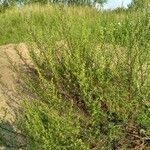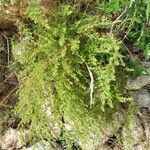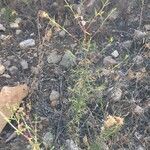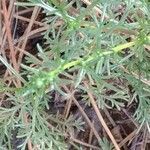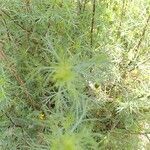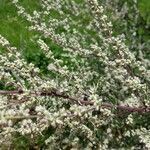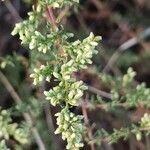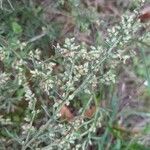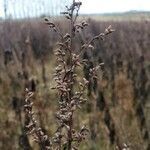Biennials or perennials, (10–)30–80(–150) cm, faintly aromatic; taprooted, caudices branched. Stems usually 1–5, turning reddish brown, (often ribbed) tomentose or glabrous. Leaves persistent or deciduous, mostly basal; basal blades 4–12 cm, cauline gradually reduced, 2–4 × 0.5–1.5 cm, 2–3-pinnately lobed, lobes linear to narrowly oblong, apices acute, faces densely to sparsely white-pubescent. Heads (pedunculate) in (mostly leafless) paniculiform arrays. Involucres broadly turbinate, 2.5–3(–5) × 2–3.5(–7) mm. Phyllaries (margins scarious) glabrous or villous-tomentose. Florets: pistillate 5–20; functionally staminate 12–30; corollas pale yellow, sparsely hairy or glabrous. Cypselae oblong-lanceoloid, somewhat compressed, 0.8–1 mm, faintly nerved, glabrous.
Shrubs, 30-60[-150] cm tall, with a strong woody stock, much branched, faintly aromatic, pubescent or glabrescent. Lowermost leaves: petiole 3-5 cm; leaf blade broadly ovate or ovate, (3-)4-5(-8) × 2.5-5 cm, 2(or 3)-pinnatisect; segments 4 or 5 pairs, 3-5-sect; lobules narrowly linear or narrowly linear-lanceolate, 4-10 × (0.5-)1-1.5[-2] mm, apex mucronulate. Middle stem leaves sessile, 1-or 2-pinnatisect; segments 3 or 4 pairs. Uppermost leaves and leaflike bracts 3-5-sect or entire. Synflorescence a lax, broad panicle. Involucre ovoid, 1.5-2.5 mm in diam. Marginal female florets 3-6[-20]. Disk florets 6-10[-30], bisexual. Achene obovoid. Fl. and fr. Jul-Oct. 2n = 18, 36.
A herb. It grows 1 m tall. It has a woody rootstock. It can be hairy. It has a faint smell. The lower leaves have leaf stalks 3-5 cm long and are broadly oval and 4-5 cm long by 3-5 cm wide. They are divided with 4 or 5 pairs of segments. The middle leaves on the stem do not have stalks.
